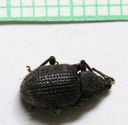Tenebrioninae
Tenebrioninae
Classification
- Phylum: Arthropoda
- Subphylum: Hexapoda
- Class: Insecta
- Order: Coleoptera
- Suborder: Polyphaga
- Superfamily: Tenebrionoidea
- Family: Tenebrionidae
- Subfamily: Tenebrioninae
Pronunciation
How to pronounce Tenebrioninae: /tɛnɛbriˈoʊnɪni/
These audio files are automatically generated. While they are not always 100% accurate, they are a good starting point.
Images






Summary
Tenebrioninae, as the largest subfamily of darkling beetles, encompasses various economically significant pests and useful model organisms. It includes over 20 tribes and exhibits diverse physical and ecological traits.
Physical Characteristics
Adults are robust, mid-sized beetles with elytra often exhibiting corrugation; typically black, dark brown, or grey with a satiny sheen; body shaped like a medication capsule or bullet; legs can be short and stout or long and spindly. Larvae are usually cylindrical to slightly flattened, with a heavily sclerotized head and visible tergites.
Identification Tips
Look for the unique mandibles and ocelli arrangement, which consists of two transverse, crescent-shaped or circular groups on each side of the head. Larvae can be identified by their frontoclypeal suture and simple malar apex.
Habitat
Found in a variety of habitats, often associated with decaying vegetation, stores, and agricultural products.
Distribution
Worldwide; prevalent in areas where food grains are stored.
Diet
Both fresh and decaying vegetation, including vegetable produce. Some are pests of flour and other cereal products.
Life Cycle
The lifecycle includes egg, larval, pupal, and adult stages, with larvae undergoing several instars before pupation.
Reproduction
Reproductive strategies may vary among species; typically involve mating followed by the female laying eggs in suitable substrates.
Predators
Predation can occur from various birds, mammals, and other insects that feed on beetles and larvae.
Ecosystem Role
Play a role in decomposition and nutrient cycling as they feed on decaying organic matter and can affect food storage systems.
Economic Impact
Several species are commercially significant pests, particularly in cereal, grain, and flour storage, affecting agriculture.
Collecting Methods
- Sweep net collection
- Trapping in baited containers
- Hand collection from infested areas
Preservation Methods
- Drying specimens
- Freezing specimens to eliminate pests
- Using ethanol for preservation
Evolution
Tenebrioninae is a diverse subfamily with complex phylogenetic relationships, having undergone changes in classification and tribe assignment over time, particularly due to molecular findings.
Similar Taxa
Misconceptions
Many believe all darkling beetles are harmful pests; however, many play essential roles in ecosystems and have beneficial interactions.
Tags
- beetles
- darkling
- Tenebrionidae
- economically significant
- pests